%20(1).png)
What if I tell you that if you know How to Use Claude AI correctly, you will not have to;
- Extract scattered documents manually,
- Extract details from emails manually,
- Pull customer information from your CRM manually,
Claude AI is an advanced AI model that can handle these tasks for you.
You simply tell Claude what to do and it;
- Looks for company info in a spreadsheet,
- Moves to CRM when data isn’t in the spreadsheet,
- Finds company details in CRM and collects required data,
- Completes and submits the form,
Without you lifting a finger! (Okay, maybe just to type the prompt you might have to but rest... nope.)
It is possible now with their latest upgrade ⬇️
⚡Latest Upgrade | Claude 3.5 Sonnet and Claude 3.5 Haiku (October 22 2024)
In this guide, you will learn everything you need to know to become an expert at using Claude AI.
What is Claude AI?
Claude AI is a conversational AI model that can summarize text, write code, answer questions, and provide decision support, all through natural language text input. Claude generates responses in a conversational context, offering options such as retrying the question to generate a new response, remembering the conversation for adjustments, and the ability to copy or provide feedback on the generated content.
Claude was developed by Anthropic and is designed with ethical AI in mind. The company’s “Constitutional AI” approach sets principles like privacy and fairness as its objectives, and it is designed to be safer and less biased by default.
It can process up to 150 pages of text, making it a great choice for long documents or multi-day conversations, as many other models lose context after a few chats or pages of text.
To interact with Claude AI, you input a Claude prompt into the message bar to generate responses. This includes features like document uploads and the AI's capability to summarize information efficiently.
Claude is available in several forms (Haiku, Sonnet, and Opus) and can be tailored to your specific use case and budget.
You can choose;
- Claude Haiku for basic tasks,
- Claude Sonnet for medium-sized projects, or
- Claude Opus for long, complex documents.
Claude AI cannot browse the internet or understand images, like ChatGPT Plus and other larger models.
It was designed to be a more secure and responsible AI, and sacrificing these features was a deliberate choice for Anthropic.
Key features of Claude AI
- Natural Understanding: Can read and respond to natural language.
- Reasoning: Can summarize documents, calculate statistics, and write or fix code.
- Images: The Claude 3.5 Sonnet model can read handwritten notes and simple charts.
- Language: Can understand and communicate in several languages, making it great for translation.
- Projects: You and Claude together can outline, draft, or design using the "Artifacts" feature.
- Safety: Trained on a massive dataset and is unlikely to generate harmful or misleading content.
Claude Pricing Plans
Claude offers three main pricing options:
- Free Plan ($0/month)
- Claude Pro Plan ($20/month)
- Team Plan ($30/user/month)
How to Get Started With Claude AI | Step by Step
Step 1: Create a Claude Account
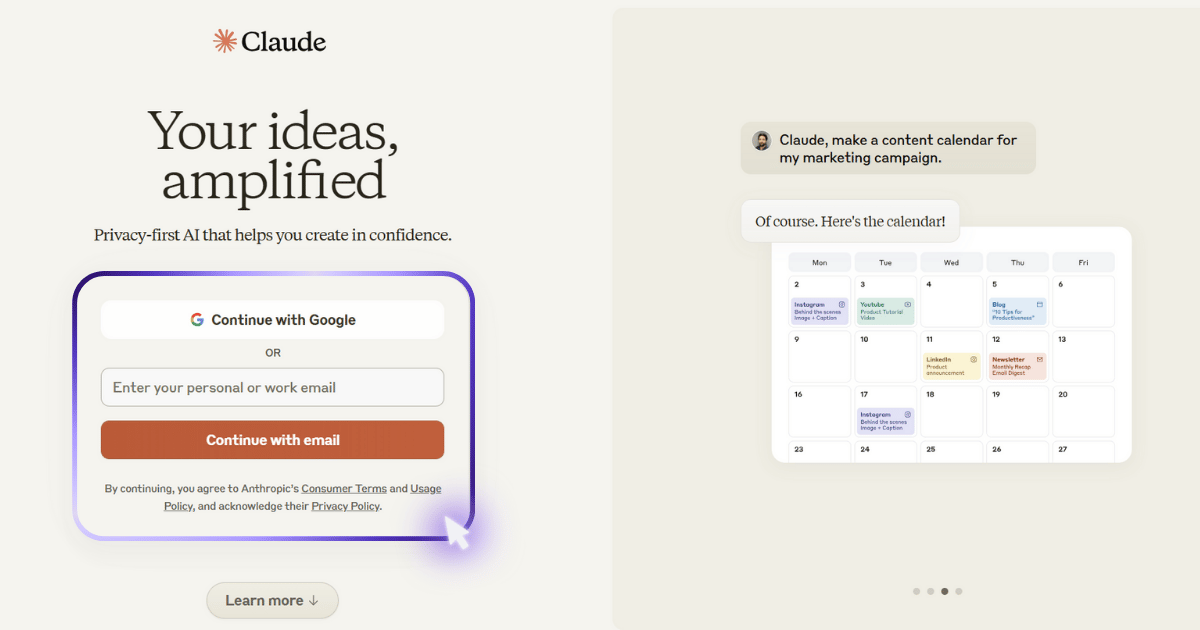
Go to the Claude Website
To use Claude, you need to create an account on the Claude website.
Users will need to collect a login code sent to their email to complete the login process.
Choose Your Sign-Up Method
You can sign up using your email or Google account.
Step 2: Verify Your Mobile Number
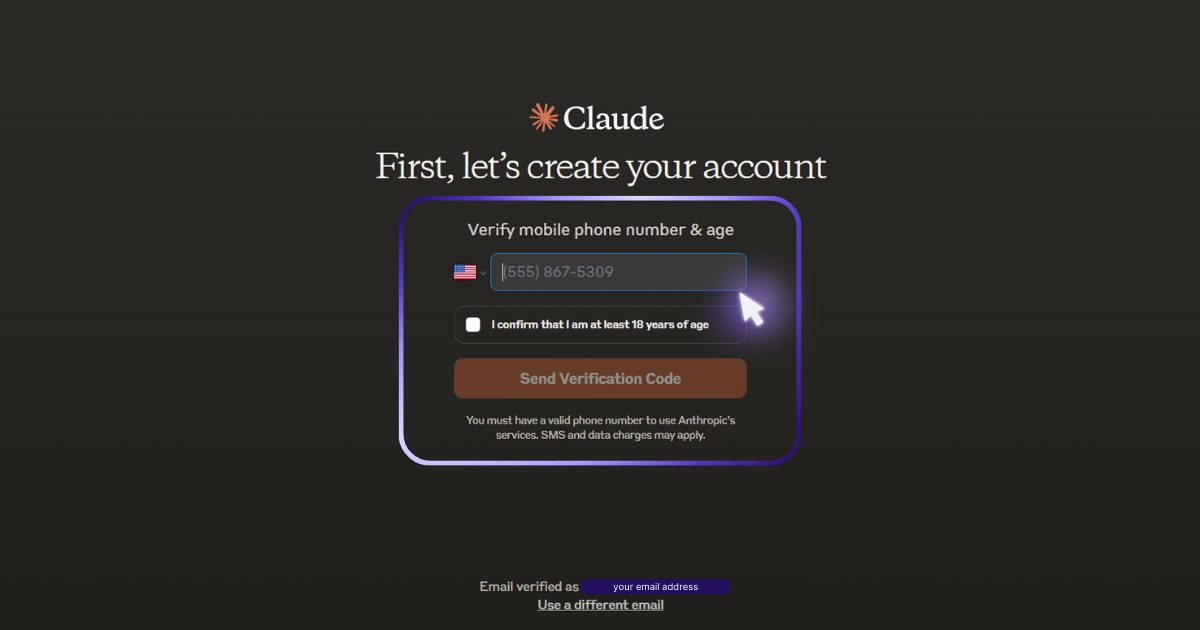
Enter Your Phone Number
After signing up, you’ll need to verify your phone number.
Confirm Age
Check the box to confirm that you are at least 18 years old.
Receive and Enter Verification Code
Claude will send a code to your mobile number. Enter this code to complete verification.
Step 3: Select Account Type
Choose Between Personal or Team Use
After completing mobile verification, you’ll reach a screen where you have to choose between
- For personal use or,
- With my team.
I’ll be selecting “For personal use”.
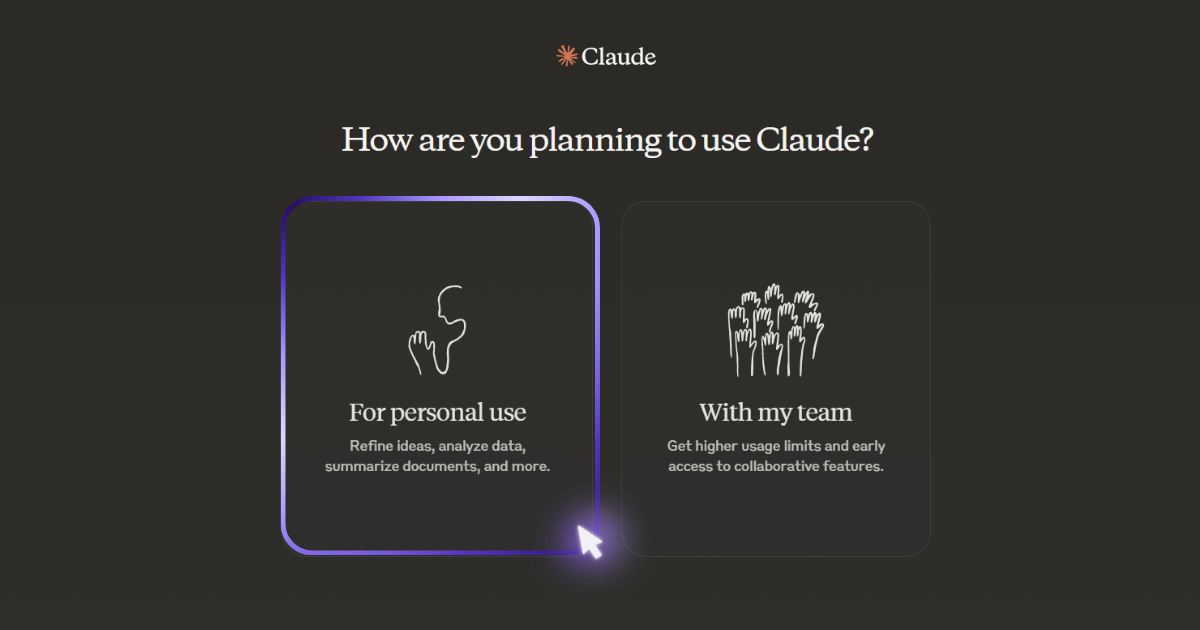
Step 4: Introduce Yourself to Claude
Enter Your Name
Next, its time to introduce yourself to Claude AI; tell your name.
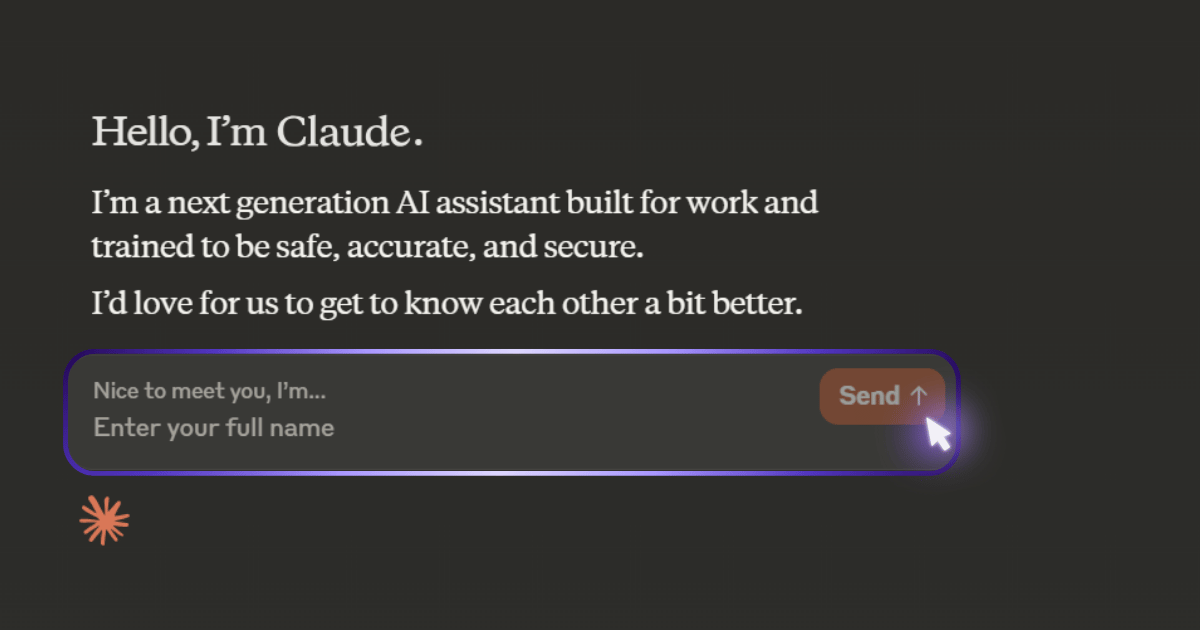
Step 5: Review and Acknowledge Disclaimers
Read Usage Policy
You will then be asked to acknowledge few things about the usage policy and anthropic regular reviews to tighten their safety systems.
Acknowledge and Continue
Give that a click.

Review Final Disclaimer
Next, you will be followed up with another set of disclaimers that is best kept in mind before proceeding with an LLM like Claude AI.
Please go ahead and give that a click as well.
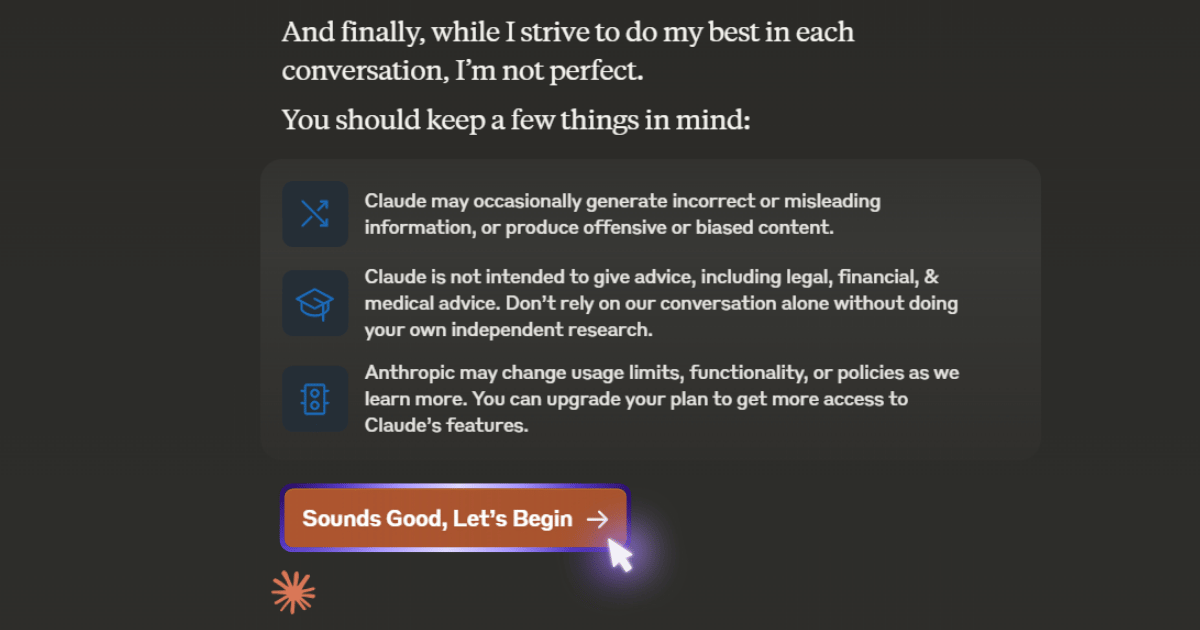
Final Confirmation
And there you have it; you have successfully signed up to Claude AI.
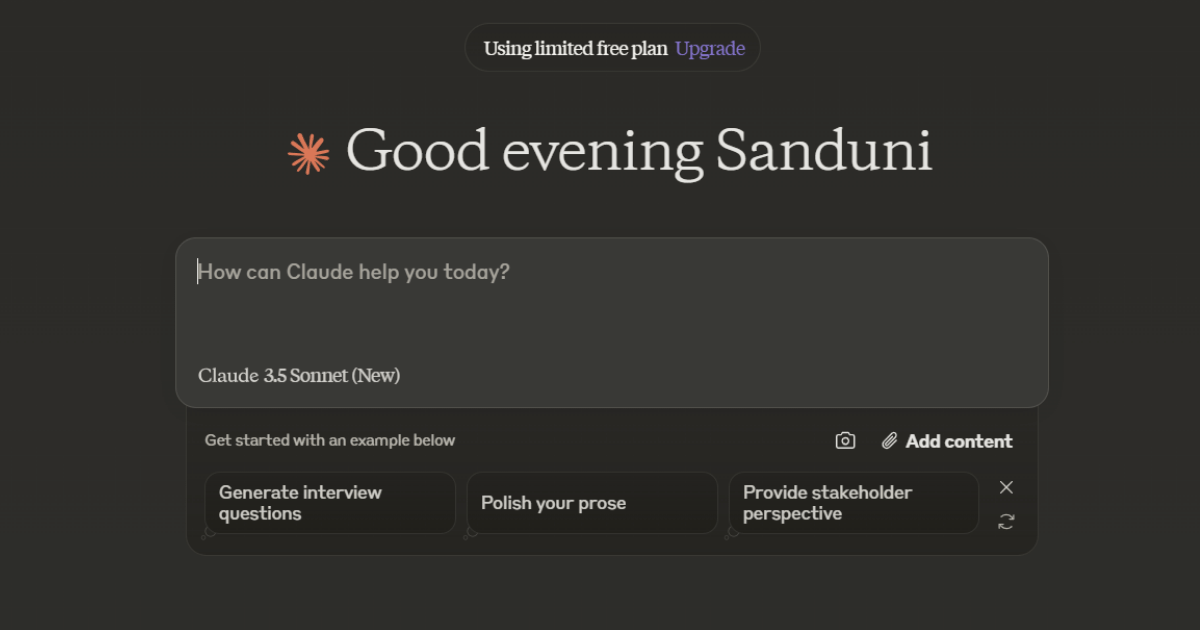
How To Navigate Claude AI
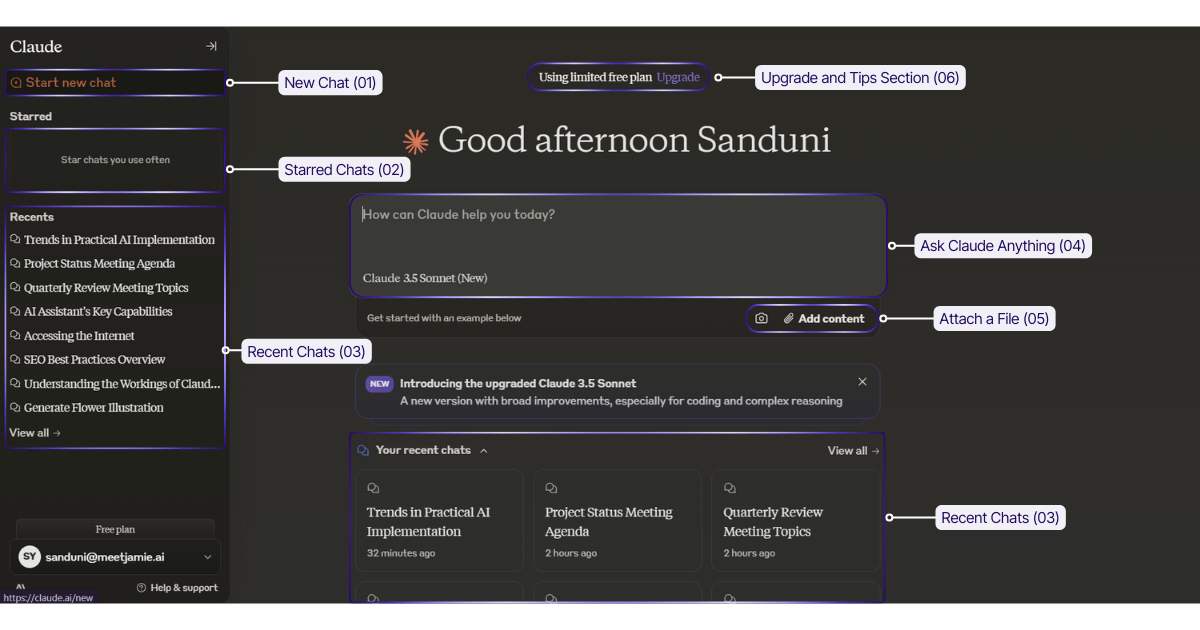
- New Chat: At the top left, you’ll see a Start a new chat button. This is perfect for starting a new topic or separating it from previous chats on the chat screen.
- Starred Chats: Below that, you’ll see a Starred section. This is where your most important conversations will live. I recommend starring ongoing projects or chats you reference frequently.
- Recent Chats: Claude saves your recent chats for you! You’ll see them on the left side under Recents and on the main screen as Your recent chats. This is a great way to pick up where you left off, revisit past topics, or reference previous insights.
- Ask Claude anything: The big box in the middle of the screen is where the magic happens! Ask Claude questions, give him commands, or enter tasks you need to complete. For example, you might ask, “How can I prepare for a quarterly review meeting?” Claude will respond with relevant advice.
- Attach a file: To the right of the prompt box, you’ll see an Attach a file button. Here, you can upload documents, images, or files you want Claude to dive into or summarize for you. This is perfect for information-dense files or data you want him to help you make sense of.
- Upgrade and Tips Section: The top banner shows your current plan and encourages you to upgrade from the limited free plan. You’ll also see helpful tips and announcements here.
How to Use Claude AI for Everyday Tasks (Prompts Included)
Meeting Preparation: Brainstorming and Agendas
Claude is helpful for planning effective meetings, from brainstorming discussion points to drafting agendas.
Brainstorming Meeting Topics
Prompt: “What are some potential topics to discuss for our upcoming quarterly review meeting?”
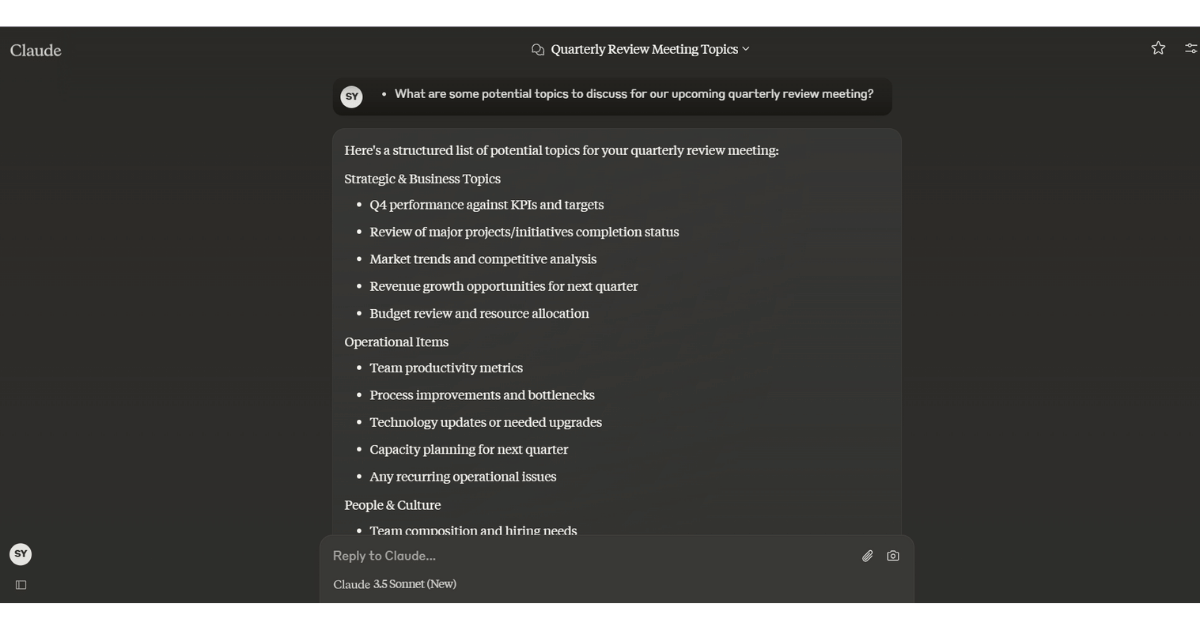
We asked Claude to brainstorm meeting topics, and it generated relevant ideas, helping you start with a solid framework.
Drafting a Meeting Agenda
Prompt: “Create a structured agenda for a 1-hour project status meeting with five main topics.”
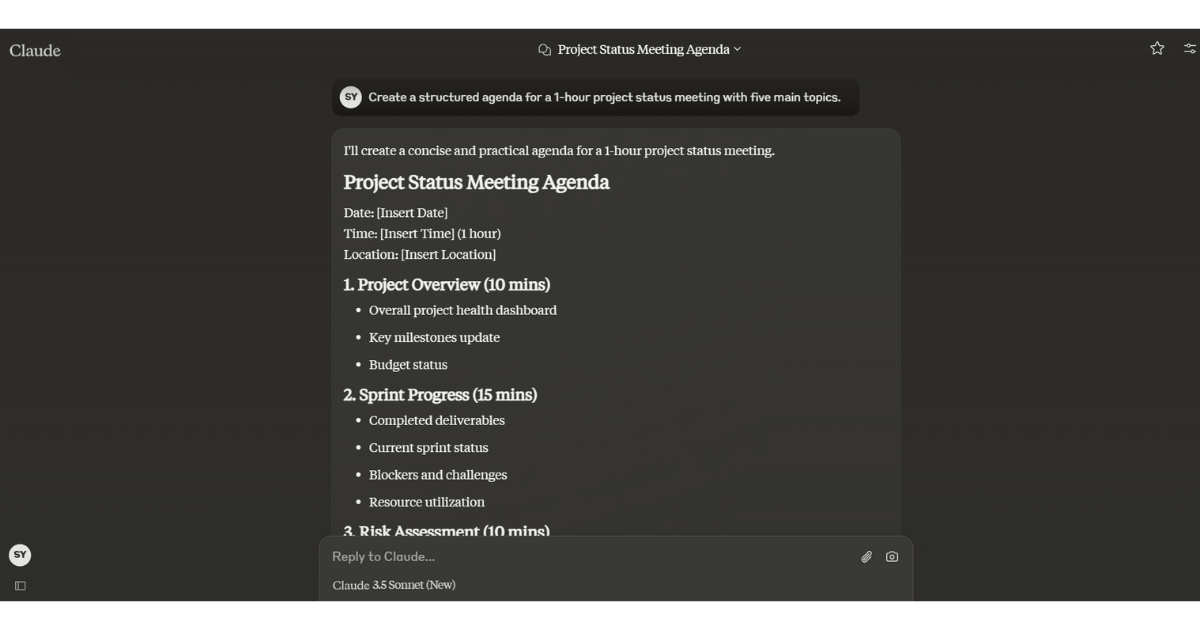
Claude will format a balanced agenda, allocating time to each topic.
Researching Background Information
Prompt: “Summarize recent trends in AI development to prepare for an upcoming technology planning meeting.”
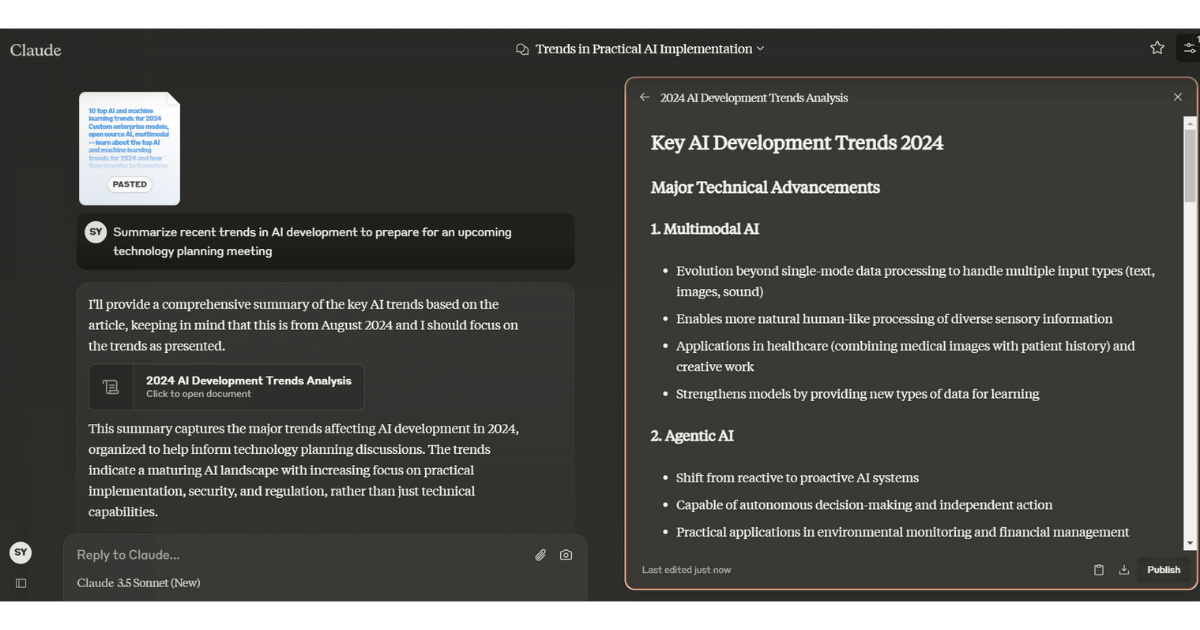
Paste relevant materials, and Claude will provide a concise overview.
In-Meeting Assistance: Note-Taking and Summarizing Discussions
Claude can make your meetings more productive by generating summaries of your meetings.
✋ But you need the transcript to generate the summaries, action items, and decisions.
You can paste the transcript in Claude and write prompts like;
- “Summarize the main decisions and next steps discussed in the meeting on Q4 marketing strategy.”
- “List all the tasks assigned in this meeting, along with the responsible person and due date.”
But what if you did not have to paste the transcript? 👀
What if there's a tool that
- Listens to your conversation (offline or online),
- Transcribes automatically (human-like amazing notes might I add),
- Generate highly organized meeting notes with smart topic detection,
- Identifies who said what with intelligent speaker identification,
- Has in built 3 powerful LLMs at your service,
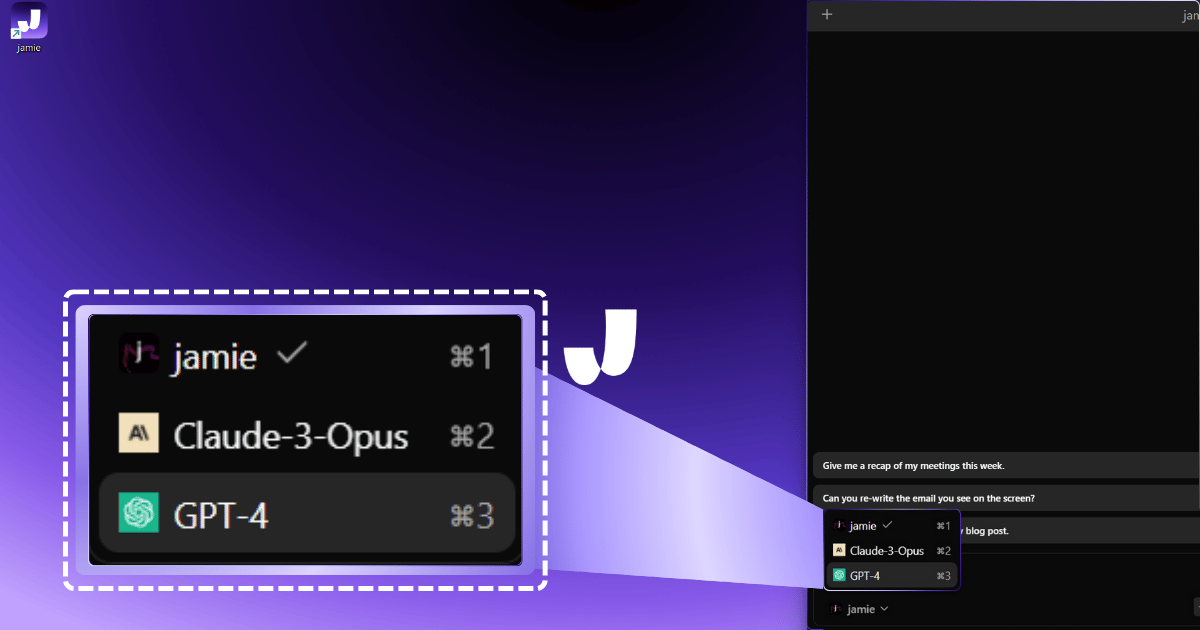
Download Jamie today for a better meeting experience. Go hands-free!
How to Use Claude 3.5 Sonnet Computer Use API for PC Automation
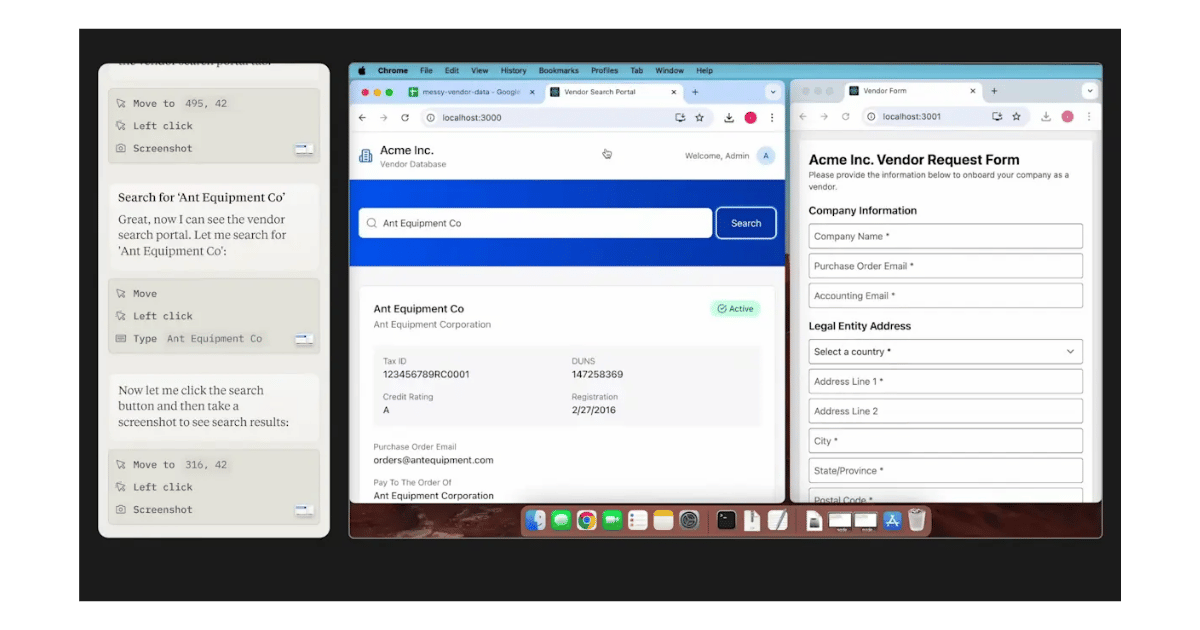
We'll cover a quick example of how to use Claude 3.5 to automate interacting with your desktop.
With Claude's new "computer use" feature in public beta, you can teach Claude to use your computer just like a human would—moving the mouse, typing, and clicking buttons.
This lets you automate desktop tasks in addition to the web automation Claude is known for.
Step 1: Access the Anthropic API
- Sign Up: Make sure you have an Anthropic API key. This is how Claude 3.5 will connect to your computer and be controlled.
- API Key: You’ll need an API key to interact with Claude through external software or scripts. You can get an API key from Anthropic. Users may need early access to use the beta feature of the API.
Step 2: Enable Computer Use Capability
- Computer Use Feature: Claude's Computer Use feature is still in beta and intended for developers, so you'll need to have access to this specific beta feature in the API.
- Permissions: Since computer use is an experimental feature, you may need to enable permissions to allow Claude to interact with your desktop and run applications or fill out forms outside of the browser.
Step 3: Set Up Code to Control Desktop Actions
To control Claude to perform desktop actions (clicking, scrolling, typing), you'll need to write scripts that interact with the API. You can do this in languages like Python. Here's a high-level example:
- Install Required Libraries:
- Install necessary libraries for interacting with Claude and your OS. Common libraries include:
pip install anthropic-api pyautogui
- PyAutoGUI is widely used for automating desktop interactions (moving the cursor, clicking, typing).
- Install necessary libraries for interacting with Claude and your OS. Common libraries include:
- Connect to the API:
- Use your API key to authenticate requests to Claude.
- A simple setup in Python could look like:
from anthropic import ClaudeClient
client = ClaudeClient(api_key="your_api_key")
- Automate Desktop Actions:
- Write commands to tell Claude what to do. With PyAutoGUI, you can script mouse and keyboard actions for Claude to perform.
- Example code to automate clicking and typing:
import pyautogui
# Move the cursor to specific screen coordinates and click
pyautogui.moveTo(100, 150)
pyautogui.click()
# Type text in a focused window
pyautogui.write("Hello from Claude!")
Step 4: Send Commands through Claude
- Command Prompts: Use prompts to direct Claude to perform certain actions:
- Example:
"Use the data from my spreadsheet and enter it into the fields on the desktop application form."
- Example:
- Monitor Actions: Since this feature is experimental, monitor Claude’s actions closely to ensure accuracy, as desktop interactions can be complex and may require testing to perfect.
Step 5: Test and Refine
Since Claude’s ability to interact with desktops is still new, it may take some adjustment:
- Test Commands: Run simple commands first (like opening and typing into Notepad) before progressing to complex workflows.
- Error Handling: Implement error handling in your scripts to manage any issues Claude encounters during automation.
For further details, visit Anthropic’s announcement on Claude’s computer use and the official API documentation.
How to Use Claude 3.5 Sonnet Computer Use Feature in Everyday Tasks
1. Filling Forms with Data Extraction
Claude 3.5 Sonnet can fill out online forms using data extracted from spreadsheets. This is great for customer information forms, updating inventory, ordering products, and more.
- Prompt:
Use the data from this spreadsheet to fill out the online request form in [website or platform name].
Claude will extract the information from each row of your spreadsheet, navigate to the online form and fill in the required data in the correct fields.
2. Automated Multi-Step Web-Based Workflows
Claude can open tabs, click links, and fill in information on multiple web pages. This multi-step automation is great when you need to gather data from several websites and put it into one report.
- Prompt:
Search for the latest updates on [specific topic] from these listed sites and compile the data into the report form.
Claude will open each of the websites, gather the information, and fill out the report form. It will navigate to each step until the final result is complete.
3. Software Testing and App Validation
In computer use, Claude 3.5 can test apps by clicking on interface elements, performing multiple actions, and validating data and app responses. This is great for validating certain aspects of apps and games. It's also a time saver for developers who need to test the same functionality over and over.
- Prompt:
Test the login feature by entering different user credentials from this list, then log and report any errors encountered.
Claude will try logging in with each set of login info and report any errors or issues found.
4. Meeting Notes and Update Documents
After a meeting, Claude can open shared documents, fill in meeting notes, and update action items with deadlines. It can fill out Google Docs and update projects in project management software or CRM systems.
- Prompt:
Access the project management dashboard and update each action item from today’s meeting with assigned deadlines.
Claude will log into your calendar, find each action item and fill in the details and due dates for each.
5. Automating Calendar Updates and Scheduling Follow-Ups
Claude can access your calendar apps to schedule follow-up meetings, reminders, and events. This is great for setting reminders about deadlines or scheduling follow-up meetings with team members.
- Prompt:
Set up a follow-up meeting with [team member names] for next week to discuss today’s action items.
Claude will log into your calendar app, find a time that is available for everyone and schedule the meeting.
How Claude AI works
Step 1: Breaks Text into Little Pieces (Tokens)
Claude breaks text into tokens. Tokens are words, but they can be smaller chunks of words, like "won't," which is two tokens, not one.
This is super common with transformer models and makes sense because it allows the model to process text sequentially, one token at a time.
Step 2: Safety Rules (Constraints)
Claude is built on Constitutional AI, which means it follows a set of rules that prevent it from generating harmful, offensive, biased, or misleading responses.
Claude is trained by humans (trainers) and another AI model built for quality control. A second AI model is used to evaluate the outputs of the primary model, ensuring adherence to safety rules and correcting responses that may be harmful or unethical. This combination of human and AI feedback is a best practice and helps Claude learn what it does wrong and right.
Step 3: Trained on tons of Text
Claude was trained on stuff like books and articles to give it a broad knowledge base. This is standard for language models and helps the model "learn" language patterns and associations instead of being fed facts and beliefs.
Like many language models, Claude was trained with
- Reinforcement learning from human and AI feedback (RLHF) and
- Reinforcement learning from AI feedback (RLAIF).
This means it was trained to maximize rewards (like saying "good job") and minimize punishments (like saying "don't do that again") from its trainers and the other AI.
This is a common and effective way to fine-tune large language models.
Step 4: Privacy
Claude does not retain users personal information for a long time, and all conversations are deleted after 30 days.
User interactions are not used to train other models or for any other purpose.
This data protection and short-term data storage are especially important in fields like healthcare and finance where confidentiality is paramount.
Step 5: Long Form Text
Claude can process 200,000 tokens per interaction, which is roughly 350 pages of text. This high token limit makes it capable of handling long or complex conversations.
Claude can keep longer context in memory, which allows it to be more responsive and coherent because it can keep track of context across longer interactions. This is extra helpful for detailed or long conversations.
Claude 3 Models | Haiku, Sonnet, and Opus Explained
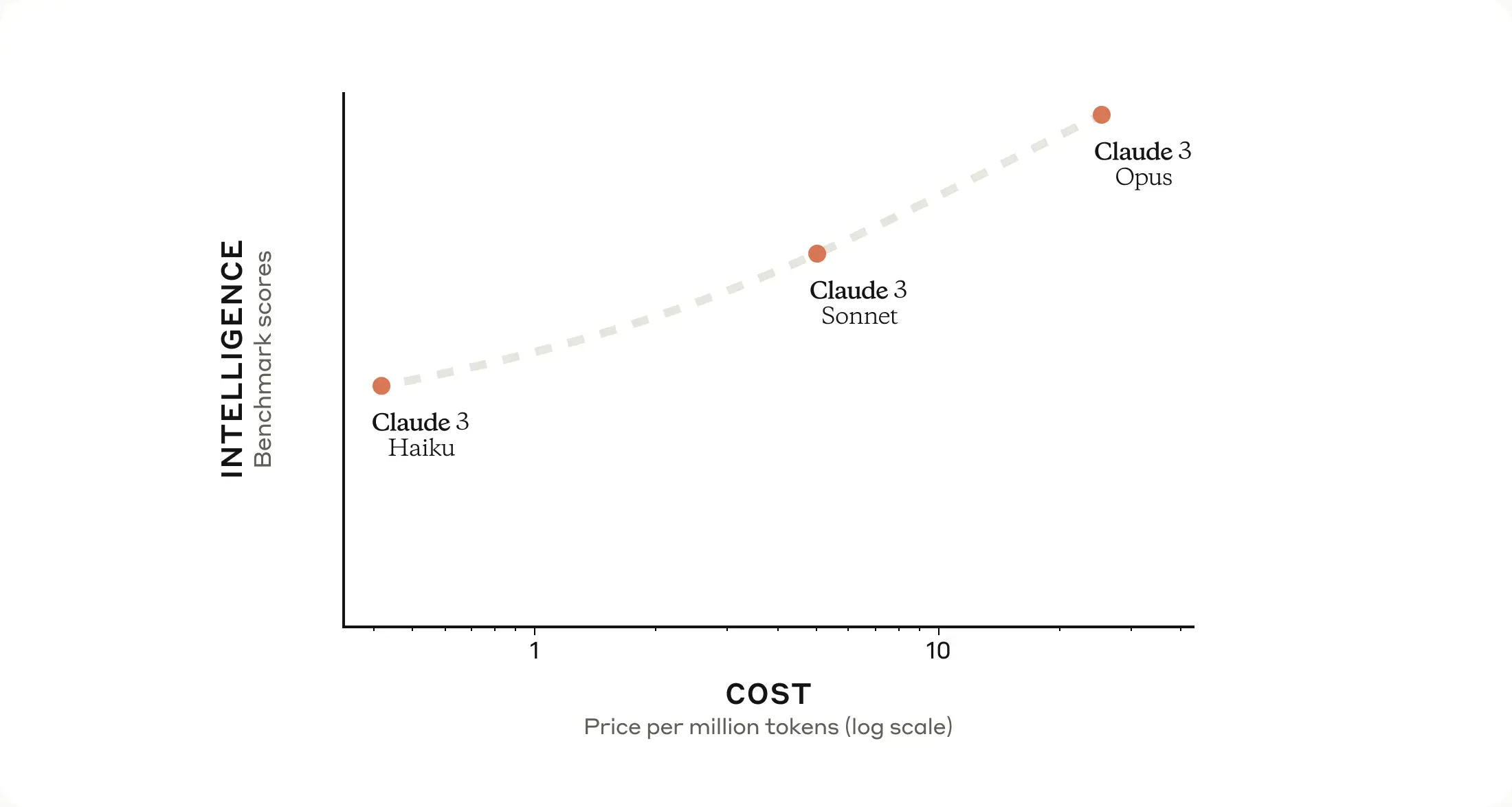
Claude AI is a language model developed by Anthropic, a safety-focused AI alignment research organization.
Anthropic's goal is to create AI that is safe, understandable, and helpful. The latest family of Claude AI models, called Claude 3, includes three main models:
- Haiku,
- Sonnet, and
- Opus.
Each model is optimized for different use cases based on a balance of intelligence, speed, and cost. Here's a brief overview of each Claude 3 model:
Claude 3 Haiku | Built for speed and cost efficiency
Haiku is designed for fast, lightweight tasks like automated customer support responses or content moderation. It can respond in real-time, but it’s not as intelligent as the other two models. Compared to an earlier version like Claude 2, Haiku shows significant improvements in speed and efficiency.
Best For: Businesses needing fast, simple AI replies.
Cost: $0.25 per million tokens for input text and $1.25 per million tokens for generated output.
Claude 3 Sonnet | Balance of intelligence and cost.
Sonnet strikes a balance between speed and intelligence. It’s a middle-of-the-road model that’s well-suited for data processing and personalized product recommendations.
Best For: Companies requiring thorough AI analysis but not to a full extent.
Cost: $3 per million tokens for input text and $15 per million tokens for generated output.
Claude 3 Opus | Most Intelligent Designed For Complex Tasks
Opus has human-level reasoning capabilities, so it can understand and respond to long, complex prompts. It's well-suited for advanced research, long-term planning, and in-depth strategic thinking.
Opus also has a larger context window of 200,000 tokens, which is important for detailed, creative tasks that require remembering context from one part of a conversation to another.
Cost: $15 per million tokens for input text and $75 per million tokens for generated output.
Best For: Users who need precise, complex, and highly intelligent responses, like scientists, strategists, or advanced R&D teams
- Claude AI uses large neural networks trained on lots of text to understand and respond to human-like dialogue.
- It’s a Large Language Model (LLM) trained to recognize patterns in large volumes of text.
- Claude AI uses a fine-tuning method called constitutional AI to create more natural and useful text.
Conclusion: Best Meeting Assistant—Claude AI or Jamie?
If you’re looking at Claude for meetings, here are the key differences: Claude automates some tasks, but Jamie is a full-service meeting assistant that eliminates repetitive steps and manual work. Here’s why Jamie is the way to go for meetings:
.png)
Jamie is designed to manage your entire meeting from start to finish in one intuitive app. By automatically saving transcripts, Jamie cuts manual work, saves time, and protects your privacy.
Plus, you get detailed, organized meeting insights. Jamie transforms the way you approach meetings, making her the best choice if you want to automate your entire meeting experience.
FAQs on How To Use Claude
What is Claude AI?
Claude AI is an AI assistant from Anthropic that can summarize, generate content, and answer your questions. It was built with safety and ethics in mind. If you're looking for meeting assistance to increase productivity, apps like Jamie that automatically capture, transcript, and summarize meetings may be a better fit for you.
How Do I Start Using Claude?
Steps:
- Sign up for Claude here.
- Chat with Claude’s interface or access it via API.
- Enter text prompts or upload documents for file-based analysis.
- Start chatting by typing your questions into the chat box.
Claude is best suited for content creation, data analysis, and general Q&A use cases.
If you have a large number of meetings to attend, Jamie can help you with hands-free transcription and automated note-taking.
Will Claude Transcribe My Live Meetings?
No, Claude does not provide live meeting transcription. You'll need to use a separate recording captioning service or provide your own transcribed text and upload it to Claude for analysis. If you need real-time transcription, Jamie's automated, simultaneous transcription and post-meeting summaries may be a better fit.
Can Claude Generate Follow-up Tasks From My Meetings?
Claude can be prompted to generate summary and follow-up tasks from uploaded documents, but it won't automatically identify action items like integrated meeting tools like Jamie. If you want to capture decisions and assign tasks immediately after meetings, Jamie's post-meeting summary and follow-up features may be a better fit.
Can Claude Help Me During My Meetings?
No, Claude is intended as a post-meeting tool. You'll upload transcripts and ask questions afterwards. Real-time meeting assistance, like what Jamie's Executive Assistant Sidebar provides the ability to ask questions and get insights without leaving your meetings. Just hit CTRL + J and the Sidebar will be right beside you.
Can Claude Work With Other AI Models?
Claude is a solo AI, and you'll need additional tools to access other AI capabilities. Jamie integrates multiple AI models (Claude 3 Opus, ChatGPT-4, and Jamie's custom model) to handle everything from brainstorming to analysis and summarization in a single app.
How Does Claude Handle Privacy?
Claude has standard privacy protections in place. If you're concerned about privacy, be sure to review the privacy options for any third-party integrations you set up. If you're looking for a meeting-focused solution, Jamie is privacy-first, with encrypted data and zero-knowledge security, meaning your organization is in control and holds the keys to your data. Jamie is bot-free, so you don't have to worry about unknown actors or data leaks.
Sanduni Yureka is a Growth Content Editor at Jamie, known for driving a 10x increase in website traffic for clients across Singapore, the U.S., and Germany. With an LLB Honors degree and a background in law, Sanduni transitioned from aspiring lawyer to digital marketing expert during the 2019 lockdown. She now specializes in crafting high-impact SEO strategies for AI-powered SaaS companies, particularly those using large language models (LLMs). When she’s not binge-watching true crime shows, Sanduni is obsessed with studying everything SEO.
Read more
3 min to save 1000 hours
Download Jamie now
Start your meeting
Super-charge your workday




.png)
.png)

.-p-500.png)


